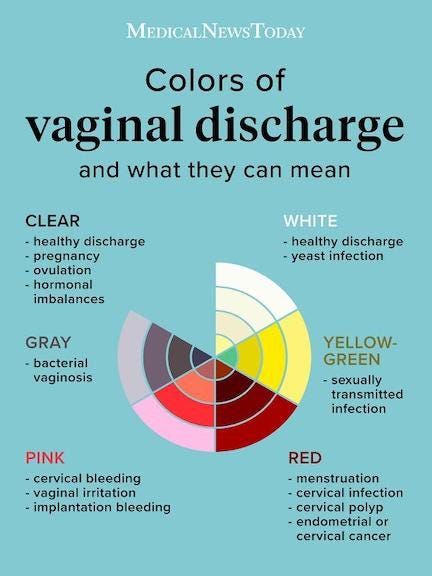Menstrual blood isn’t just “red”—it comes in various shades, each with its own story about your health. Understanding these variations can provide insights into your hormonal balance, overall well-being, and potential health issues. This guide dives into the different colors of menstrual blood, their meanings, and when you might need to consult a healthcare professional.
Why Does Menstrual Blood Vary in Color?
The color of menstrual blood depends on several factors, including its age, the flow rate, and the mix of blood, uterine lining, and cervical fluid. These variations are normal and often harmless, but they can sometimes indicate underlying conditions. Paying attention to these changes can empower you to better understand your body.
Common Menstrual Blood Colors and What They Mean
Bright Red
-
What it Indicates
Bright red blood is typically fresh and signifies active bleeding. It’s most common at the start of your period when your flow is heavier.
-
When It’s Normal
A bright red flow is normal during the first few days of menstruation.
-
When to Watch Out
If bright red bleeding occurs outside of your period or continues for more than seven days, it could indicate hormonal imbalances, fibroids, or an underlying issue that requires medical attention.
Dark Red or Brown
-
What it Indicates
Dark red or brown blood is older blood that has taken longer to exit the uterus. This often appears at the start or end of your period.
-
When It’s Normal
Seeing brown or dark red blood during lighter flow days is common.
-
When to Watch Out
If brown discharge occurs mid-cycle or has an unusual odor, it might signal an infection or other health concern.
Pink
-
What it Indicates
Pink blood usually occurs when period blood mixes with cervical fluid, resulting in a diluted appearance.
-
When It’s Normal
Pink spotting can happen during the start or end of your period or after intense exercise.
-
When to Watch Out
Persistent pink bleeding outside your cycle could suggest hormonal imbalances, anemia, or early pregnancy complications.
Orange
-
What it Indicates
Orange blood might occur due to the mixing of blood with cervical fluids.
-
When It’s Normal
It’s less common but can occasionally appear during light spotting.
-
When to Watch Out
If accompanied by a foul odor or discomfort, it could indicate an infection such as bacterial vaginosis or a sexually transmitted infection (STI).
Gray
-
What it Indicates
Gray blood often points to an infection or miscarriage.
-
When It’s Normal
Gray blood is rarely normal and should be evaluated by a doctor immediately.
-
When to Watch Out
Seek medical attention if you notice gray discharge, especially if accompanied by a strong odor, fever, or pelvic pain.
Black
-
What it Indicates
Black blood is typically very old blood that has taken a long time to leave the uterus.
-
When It’s Normal
It can occasionally appear at the very beginning or end of a period.
-
When to Watch Out
If black blood is accompanied by pain or an unpleasant odor, it could signal a blockage or infection.
Other Factors That Affect Menstrual Blood Color
Flow Intensity
Heavier flows tend to produce brighter red blood, while lighter flows or spotting are often darker.
Age of Blood
Blood that stays in the uterus longer oxidizes, leading to darker shades like brown or black.
Hormonal Changes
Hormonal fluctuations, such as those caused by birth control, pregnancy, or menopause, can impact blood color.
Infections and Medical Conditions
Conditions like polycystic ovary syndrome (PCOS), endometriosis, or pelvic inflammatory disease (PID) can influence the appearance of menstrual blood.
When to See a Doctor
While variations in color are usually normal, certain symptoms warrant professional evaluation:
-
Bleeding Between Periods
Consistent spotting or bleeding outside your regular cycle could indicate hormonal issues or uterine conditions.
-
Heavy Bleeding
Soaking through a pad or tampon every hour for several hours may indicate menorrhagia (heavy menstrual bleeding).
-
Unusual Odour
A strong or foul smell accompanying unusual discharge could suggest an infection.
-
Persistent Pain
Severe cramps or pelvic pain that interferes with daily life may signal a more serious issue like endometriosis or fibroids.
Tips for Tracking Menstrual Blood Changes
Tracking your period can help you identify patterns and spot abnormalities. Use apps or a journal to log:
-
Start and End Dates: Note the length of your cycle.
-
Flow Intensity: Record whether your flow is light, moderate, or heavy.
-
Blood Colour: Observe the shades throughout your period.
-
Other Symptoms: Include cramps, bloating, or mood changes.
How to Maintain a Healthy Menstrual Cycle
-
Stay Hydrated
Drinking enough water can help keep your blood flow smooth and reduce clotting.
-
Eat a Balanced Diet
Include iron-rich foods like spinach, lean meats, and legumes to replenish lost nutrients.
-
Manage Stress
High stress levels can disrupt hormonal balance and affect your menstrual cycle.
-
Exercise Regularly
Moderate exercise can improve circulation and reduce menstrual cramps.
-
Get Regular Check-Ups
Routine gynecological exams can help detect and address any menstrual irregularities early.
Final Thoughts
Menstrual blood colors can be a window into your overall health. While most variations are normal, staying informed and proactive is key to maintaining well-being. If you notice persistent abnormalities or concerning symptoms, consult a healthcare professional for guidance. By paying attention to your cycle, you can take charge of your health and ensure peace of mind.
Disclaimer: This article is for informational purposes only and does not replace professional medical advice. Always consult a healthcare provider for any concerns.


